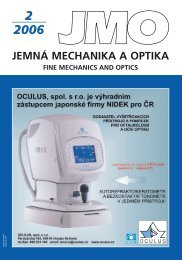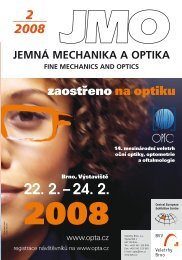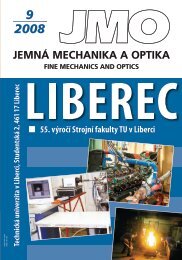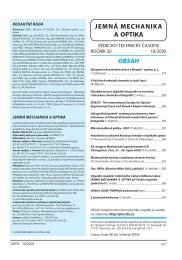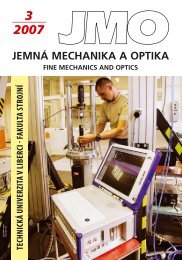You also want an ePaper? Increase the reach of your titles
YUMPU automatically turns print PDFs into web optimized ePapers that Google loves.
spectrum of a (standard) light source (illuminant) illuminating the<br />
sample and x( λ),<br />
y( λ),<br />
z( λ)<br />
are the CIE standard stimuli spectral<br />
curves (color-matching functions). The normalizing coefficient<br />
k is suitably chosen on a scale having tristimulus value Y = 100 for<br />
a perfectly diffusing surface in the case of opaque sample, or for<br />
a perfectly transparent and scattering sample. L * represents the color<br />
luminance values with luminous scale from 0 to 100 (0 � black,<br />
100 � white), while a * and b * denote the representative chromaticity<br />
(coloring) values (+a * � red, -a * � green, +b * � yellow, -b * � blue).<br />
The corresponding color hue is denoted by H * and the color saturation<br />
(chroma) values are C * . In the case of the Munsell color notation<br />
(H,V,C), the color coordinates H, V and C relate to the values H * , L *<br />
and C * with differend scales. They can be converted from X, Y and<br />
Z values using the procedure of ASTM [19].<br />
4. EXAMPLES OF SOIL COLOR EFFECTS<br />
From the previous text follows that the soil redness effects can<br />
be profitably estimated either on the basis of K-M theory or by<br />
means of the redness rates which are accepted by Eqs. (17) – (19).<br />
In this section, examples of both approaches are shown.<br />
For soil color assessments it is necessary to prepare at first the<br />
relevant soil samples and, if need be, a suitable comparative white<br />
standard. The manner in which a soil sample is prepared markedly<br />
affects, namely, the color characteristic values and functions.<br />
Unfortunately, no standard method of sample preparation has<br />
been adopted by soil scientists so far. This fact makes difficulty of<br />
unambiguous comparison the results obtained by different authors.<br />
The only common experience is that the color sample material<br />
should be suitably treated (processed), finely divided (grinded,<br />
powdered) and gently pressed to tablets of circulat or rectangular<br />
cross-section and relevant sizes. In such cases, the colors appear<br />
expressive in dependence of the concrete sample production,<br />
sample sort, sample physical state, sample frame and holder, exploited<br />
theoretical approach, measuring procedure and measuring<br />
conditions [1,4,8-10,15].<br />
The results of color determination under K-M theory obtained<br />
so far for different untreated or treadet soil mixtures show marked<br />
differences of the corresponding spectra A M (λ), S M (λ), R M (λ)<br />
and A h (λ), A g (λ), A r (λ), S h (λ), S g (λ), S r (λ), or of their averages.<br />
Example of smoothed specific reflectance-wavelength dependences<br />
R M (λ), measured by [4] for three dry artificial binary mixtures of<br />
synthetic haematite and goethite components, is shown in Fig. 2.<br />
The chosen and indicated haematite and goethite relative contents,<br />
determined by using the differential X-ray diffraction method, are:<br />
κ h = 0, κ g = 0.099; κ h = 0.132, κ g = 0; κ h = 0.166, κ g = 0.138. The<br />
components were powdered at first by a ball mill, mixed and filled<br />
into 8x17 mm aluminium frame and then gently pressed against<br />
a filter paper to minimize preferred orientations and unsuitable<br />
specular light reflections which can occur during measurements.<br />
The reflectance values R M (λ) of the mixtures were measured from<br />
λ = 400 to 700 nm at 10 nm intervals by the double beam Perkin-<br />
-Elmer Lambda 3 spectrophotometr equipped with a reflectance<br />
(integrating sphere) attachment. The comparative white standard<br />
material was barium sulfate, BaSO 4 , of R S (λ)≈1.<br />
It is evident from Fig. 2 that a pure haematite (κ g = 0) relates<br />
to smaller values of R M (λ), while a pure goethite (κ h = 0) gives<br />
larger amounts of R M (λ). In addition, the mixtures of haematite<br />
and goethite lead standardly to smaller values of R M (λ) for about<br />
λ > 500 nm. Moreover, the added comparison of measured R M (λ)<br />
values with the values calculated using the appropriately modified<br />
Eqs. (6) of the K-M theory for preliminaly known functions A n (λ)<br />
and S n (λ), mentioned in [4], shows good agreement, especially for<br />
mixtures with less than about 0.2 of haematite and goethite contents.<br />
Thus the K-M approach can be also safely used for predicting the<br />
spectral properties of mixtures mentioned above. However, a moister<br />
existence causes unwanted specular light reflections that creates<br />
problems in applications of the K-M theory.<br />
������<br />
Fig. 2 Example of smoothed specific reflectance – wavelength<br />
dependences R M (λ) measured for three dry artificial binary<br />
mixtures of synthetic haematite and goethite. Their contents κ h<br />
and κ g are indicated<br />
Smoothed examples of average values Ah ( λ),<br />
Ag ( λ),<br />
Ar ( λ),<br />
S h ( λ),<br />
Sg ( λ)and<br />
Sr ( λ),<br />
calculated by the minimization<br />
least-squares procedures for a common soil mixture, are shown in<br />
Figs. 3 and 4 [4]. The corresponding average reflectance spectra<br />
Rh ( λ),<br />
Rg ( λ)<br />
and Rr ( λ),<br />
calculated using the forms of general<br />
Eqs. (4), are illustrated in Fig. 5. They relate to the Munsell color<br />
system (H,V,C) of color coordinates H = 3.4 YR, V = 4.6, C = 6.6<br />
for haematite, H = 9.2 YR, V = 5.5, C = 4.5 for goethite, and H = 6.7<br />
YR, V = 7.5, C = 2.2 for the iron-free residue. Hence, the soil haematite<br />
appears slightly yellower and lighter than most of the synthetic<br />
haematites [20], while the soil goethite is slightly redder and it is of<br />
lower chroma than most of the synthetic goethites [21]. Finally, the<br />
soil iron oxide-free component appears pinkish gray in comparison<br />
with, for example, the gray dithionite-treated soils.<br />
Fig. 3 Example of calculated and smoothed average absorbance<br />
spectra Ah ( λ),<br />
Ag ( λ)<br />
and Ar ( λ)<br />
for a common soil mixture<br />
��



